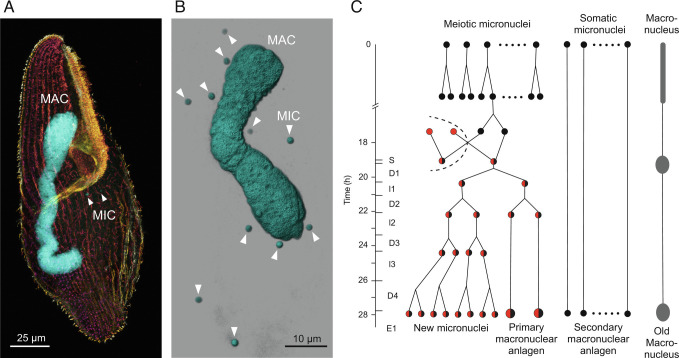Fig. 1.
Blepharisma nuclei and nuclear development during conjugation. (A) Cell of B. stoltei strain ATCC 30299 stained with anti-alpha-tubulin-Alexa488 (depth color-coded) and the dsDNA dye DAPI (cyan). (B) Snapshot of a 3D reconstruction (Imaris, Bitplane) from CLSM fluorescence images of a cell stained with the dsDNA dye Hoechst 33342 (Invitrogen). (C) Schematic of the nuclear processes occurring during conjugation in Blepharisma, classified according to, and modified from figure 45 of ref. 6 (copyright, Elsevier). During conjugation, half of the MICs in each cell undergo meiosis (meiotic MICs), and the rest do not (somatic MICs). One of the meiotic MICs eventually gives rise to two haploid gametic nuclei, one of which (the migratory nucleus) is exchanged with that of its partner. Subsequently, the migratory and stationary haploid nuclei fuse to generate a zygotic nucleus (synkaryon), which, after successive mitotic divisions, gives rise to both new MICs and new MACs (known as primary anlagen). The new MACs continue to mature, eventually growing in size and DNA content (6). In parallel, secondary macronuclear anlagen develops directly, and with time, the old MAC condenses and degrades. After karyogamy, cells are classified into ten stages: S (synkaryon), D1 (first mitosis), I1 (first interphase), D2 (second mitosis), I2 (second interphase), D3 (third mitosis), I3 (third interphase), D4 (fourth mitosis), E1 (first embryonic stage), and E2 (second embryonic stage; not shown).

